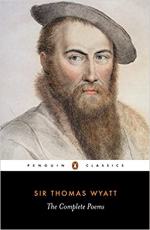|
This section contains 406 words (approx. 2 pages at 400 words per page) |

|
I Find No Peace Summary & Study Guide Description
I Find No Peace Summary & Study Guide includes comprehensive information and analysis to help you understand the book. This study guide contains the following sections:
This detailed literature summary also contains Quotes and a Free Quiz on I Find No Peace by .
The following version of the poem was used to create this guide: Wyatt, Sir Thomas. "I Find No Peace." Poetry Foundation. https://www.poetryfoundation.org/poems/45579/i-find-no-peace.
Note that all parenthetical citations within the guide refer to the lines of the poem from which the quotations are taken.
Sir Thomas Wyatt was born in 1503 at his parents’ castle in Kent. His father was a powerful member of the Tudor court, and Wyatt was likely educated at Cambridge. When he was 17, he was married to Elizabeth Brooke, who soon bore him a son. Wyatt enjoyed a successful career in Henry VIII’s court, taking on the positions of esquire of the king’s body and clerk of the king’s jewels. Though not necessarily glamorous, these roles gave him access to the king’s person that put him in a position of significant power. Around 1525, Wyatt “cast his wife away” (as close as he could come to divorce) due to allegations that she was adulterous. He received several important political and military honors, and around 1536 became involved with Elizabeth Darrell, who was his mistress for the rest of his life.
Unfortunately for Wyatt, he also became associated with Anne Boleyn, Henry VIII’s second wife. When Boleyn was accused of adultery against the king with trumped-up charges (intended to allow the king to rid himself of her and remarry, as he had previously done in his divorce from Catherone of Aragon), Wyatt’s name was put forward. Scholars still debate whether there is any veracity to the rumors that he was Anne Boleyn’s lover – most believe that Anne Boleyn was never unfaithful to Henry VIII, but whether there was any involvement is still in question. Wyatt, alone of the accused, was found innocent of the charges and freed, but his reprieve was not to last long. In 1541, his patron, Cromwell, was accused of treason, though the real motive was his role in proposing the king’s marriage to Anne of Cleves, who the king found sexually unappealing. Cromwell was soon executed, and Wyatt found himself under arrest. He confessed to charges of treason, but was pardoned, possibly due to the involvement of Henry’s fifth wife, Queen Cathrine Howard. In 1542, likely restored to some measure of royal favor, Wyatt died of a fever.
This poem is a translation of a Petrarchan sonnet that uses opposition to show the pains of unrequited love.
Read more from the Study Guide
|
This section contains 406 words (approx. 2 pages at 400 words per page) |

|



